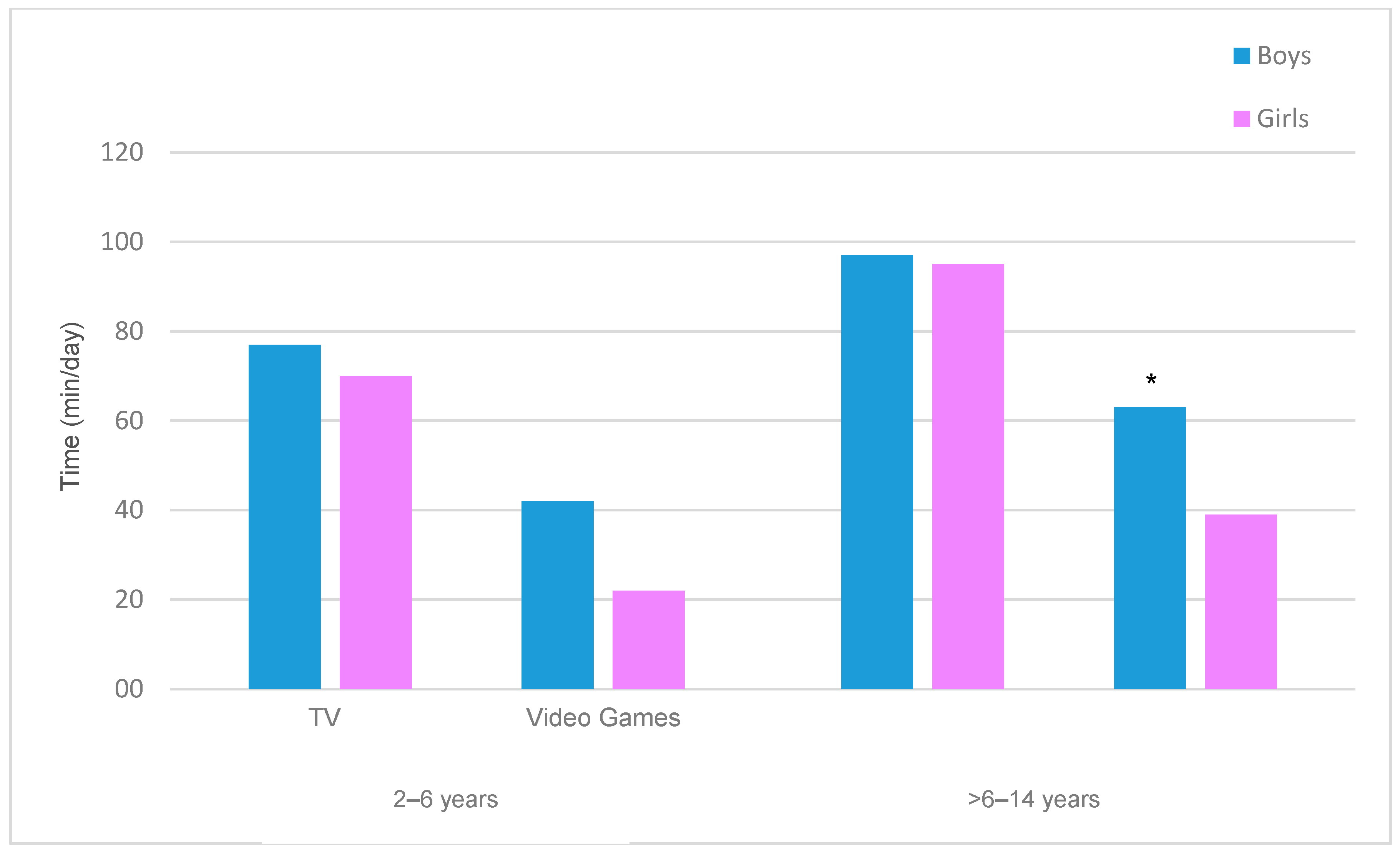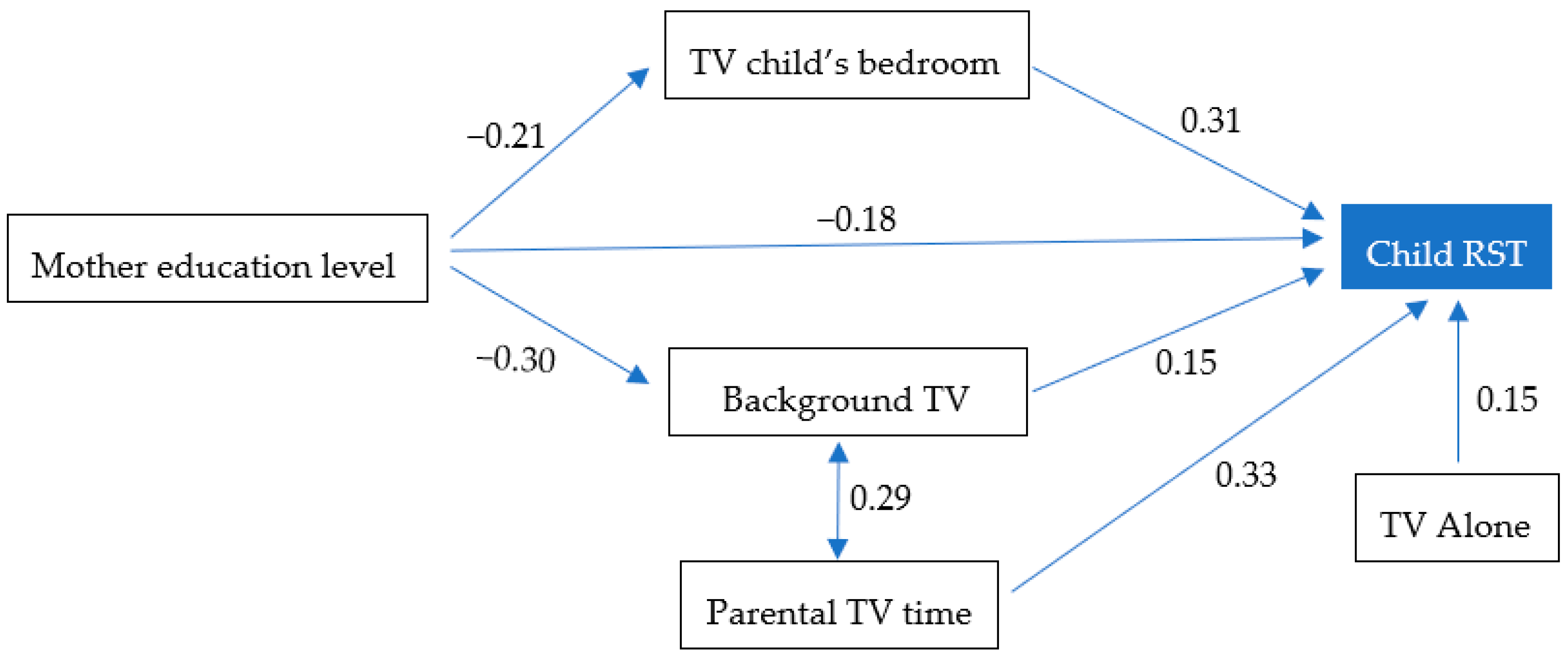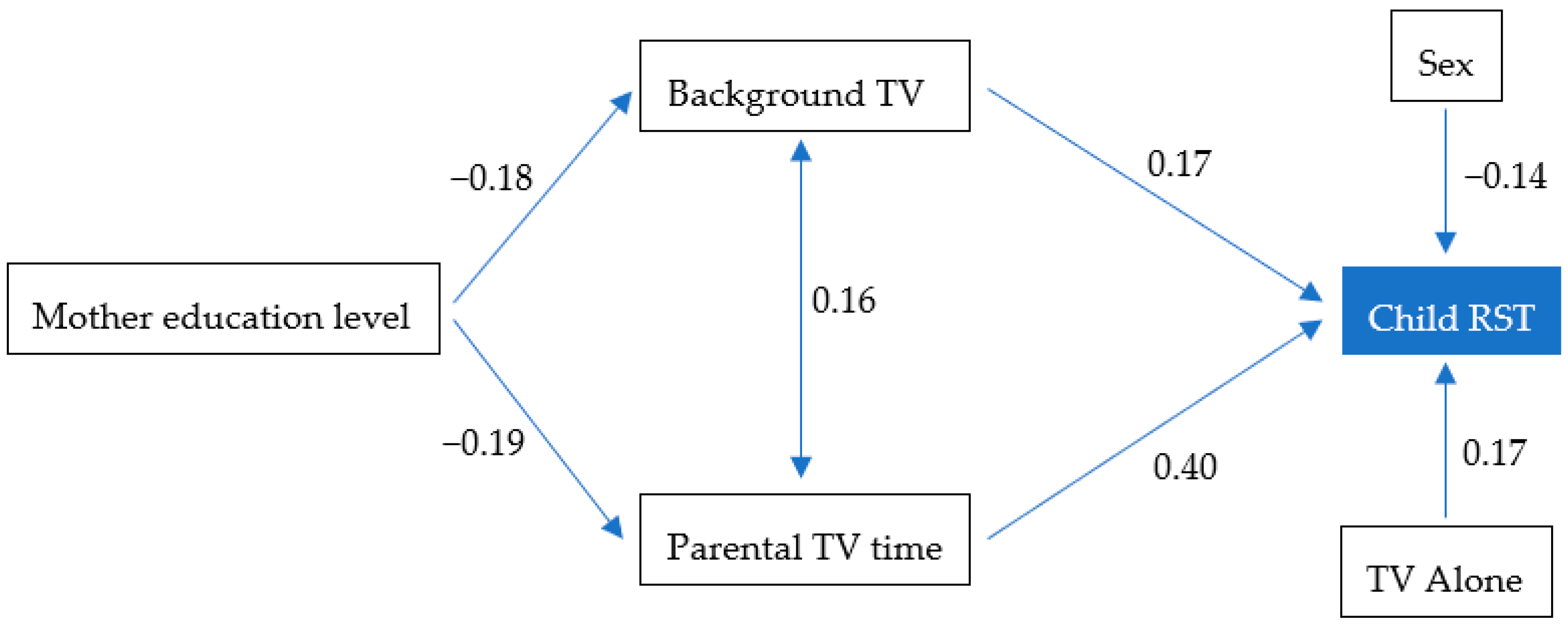Maternal Education Level and Excessive Recreational Screen Time in Children: A Mediation Analysis
Abstract
:1. Introduction
2. Materials and Methods
2.1. Design and Sample
2.2. Measures
2.3. Statistical Analysis
3. Results
4. Discussion
5. Conclusions
Author Contributions
Funding
Acknowledgments
Conflicts of Interest
References
- Marshall, S.J.; Gorely, T.; Biddle, S.J. A descriptive epidemiology of screen-based media use in youth: A review and critique. J. Adolesc. 2006, 29, 333–349. [Google Scholar] [CrossRef]
- Media, C.O.C.A. Media Use in School-Aged Children and Adolescents. Pediatrics 2016, 138, e20162592. [Google Scholar] [CrossRef]
- Hinkley, T.; Salmon, J.; Okely, A.D.; Crawford, D.; Hesketh, K. Preschoolers’ Physical Activity, Screen Time, and Compliance with Recommendations. Med. Sci. Sports Exerc. 2012, 44, 458–465. [Google Scholar] [CrossRef] [PubMed]
- Latomme, J.; Van Stappen, V.; Cardon, G.; Morgan, P.J.; Lateva, M.; Chakarova, N.; Kivelä, J.; Lindström, J.; Androutsos, O.; Gonzalez-Gil, E.M.; et al. The Association between Children’s and Parents’ Co-TV Viewing and Their Total Screen Time in Six European Countries: Cross-Sectional Data from the Feel4diabetes-Study. Int. J. Environ. Res. Public Health 2018, 15, 2599. [Google Scholar] [CrossRef] [PubMed] [Green Version]
- Fernández-Alvira, J.M.; Velde, S.J.T.; Singh, A.; Jimenez-Pavon, D.; De Bourdeaudhuij, I.; Bere, E.; Manios, Y.; Kovacs, E.; Jan, N.; Moreno, L.A.; et al. Parental modeling, education and children’s sports and TV time: The ENERGY-project. Prev. Med. 2015, 70, 96–101. [Google Scholar] [CrossRef]
- Cillero, I.H.; Jago, R. Systematic review of correlates of screen-viewing among young children. Prev. Med. 2010, 51, 3–10. [Google Scholar] [CrossRef]
- Mielgo-Ayuso, J.; Aparicio-Ugarriza, R.; Castillo, A.; Ruiz, E.; Avila, J.M.; Aranceta-Bartrina, J.; Gil, A.; Ortega, R.M.; Serra-Majem, L.; Varela-Moreiras, G.; et al. Sedentary behavior among Spanish children and adolescents: Findings from the ANIBES study. BMC Public Health 2017, 17, 94. [Google Scholar] [CrossRef] [Green Version]
- Rey-López, J.P.; Vicente-Rodriguez, G.; Ortega, F.B.; Ruiz, J.R.; Martinez-Gómez, D.; De Henauw, S.; Manios, Y.; Molnar, D.; Polito, A.; Verloigne, M.; et al. Sedentary patterns and media availability in European adolescents: The HELENA study. Prev. Med. 2010, 51, 50–55. [Google Scholar] [CrossRef]
- Perez-Farinos, N.; Villar-Villalba, C.; López-Sobaler, A.M.; Dal-Re, M.Á.; Aparicio, A.; Santos, S.; Robledo, T.; Castrodeza-Sanz, J.J.; Ortega, R.M. The relationship between hours of sleep, screen time and frequency of food and drink consumption in Spain in the 2011 and 2013 ALADINO: A cross-sectional study. BMC Public Health 2017, 17, 33. [Google Scholar] [CrossRef] [Green Version]
- Carson, V.; Hunter, S.; Kuzik, N.; Gray, C.E.; Poitras, V.J.; Chaput, J.-P.; Saunders, T.J.; Katzmarzyk, P.T.; Okely, A.D.; Gorber, S.C.; et al. Systematic review of sedentary behaviour and health indicators in school-aged children and youth: An update. Appl. Physiol. Nutr. Metab. 2016, 41, S240–S265. [Google Scholar] [CrossRef]
- Jones, R.A.; Hinkley, T.; Okely, A.D.; Salmon, J. Tracking physical activity and sedentary behavior in childhood: A systematic review. Am. J. Prev. Med. 2013, 44, 651–658. [Google Scholar] [CrossRef] [PubMed]
- Tremblay, M.S.; Leblanc, A.G.; Kho, M.E.; Saunders, T.J.; Larouche, R.; Colley, R.C.; Goldfield, G.S.; Gorber, S.C. Systematic review of sedentary behaviour and health indicators in school-aged children and youth. Int. J. Behav. Nutr. Phys. Act. 2011, 8, 98. [Google Scholar] [CrossRef] [PubMed] [Green Version]
- Ferguson, C.J. Do Angry Birds Make for Angry Children? A Meta-Analysis of Video Game Influences on Children’s and Adolescents’ Aggression, Mental Health, Prosocial Behavior, and Academic Performance. Perspect. Psychol. Sci. 2015, 10, 646–666. [Google Scholar] [CrossRef] [PubMed]
- Adelantado-Renau, M.; Moliner-Urdiales, D.; Cavero-Redondo, I.; Beltran-Valls, M.R.; Martinez-Vizcaino, V.; Alvarez-Bueno, C. Association between Screen Media Use and Academic Performance Among Children and Adolescents: A Systematic Review and Meta-analysis. JAMA Pediatr. 2019, 173, 1058–1067. [Google Scholar] [CrossRef]
- Kostyrka-Allchorne, K.; Cooper, N.R.; Simpson, A. The relationship between television exposure and children’ cognition and behaviour: A systematic review. Dev. Rev. 2017, 44, 19–58. [Google Scholar] [CrossRef]
- Gentile, D.A.; Swing, E.L.; Lim, C.G.; Khoo, A. Video game playing, attention problems, and impulsiveness: Evidence of bidirectional causality. Psychol. Popul. Media Cult. 2012, 1, 62–70. [Google Scholar] [CrossRef] [Green Version]
- De Craemer, M.; Lateva, M.; Iotova, V.; De Decker, E.; Verloigne, M.; De Bourdeaudhuij, I.; Androutsos, O.; Socha, P.; Kulaga, Z.; Moreno, L.; et al. Differences in energy balance-related behaviours in European preschool children: The ToyBox-study. PLoS ONE 2015, 10, e0118303. [Google Scholar] [CrossRef]
- Biddle, S.J.; Pearson, N.; Ross, G.M.; Braithwaite, R. Tracking of sedentary behaviours of young people: A systematic review. Prev. Med. 2010, 51, 345–351. [Google Scholar] [CrossRef] [Green Version]
- Sawyer, S.M.; Afifi, R.A.; Bearinger, L.H.; Blakemore, S.-J.; Dick, B.; Ezeh, A.C.; Patton, G.C. Adolescence: A foundation for future health. Lancet 2012, 379, 1630–1640. [Google Scholar] [CrossRef]
- Duch, H.; Fisher, E.M.; Ensari, I.; Harrington, A. Screen time use in children under 3 years old: A systematic review of correlates. Int. J. Behav. Nutr. Phys. Act. 2013, 10, 102. [Google Scholar] [CrossRef] [Green Version]
- Gorely, T.; Marshall, S.J.; Biddle, S.J.H. Couch kids: Correlates of television viewing among youth. Int. J. Behav. Med. 2004, 11, 152–163. [Google Scholar] [CrossRef] [PubMed]
- Pate, R.R.; Mitchell, J.A.; Byun, W.; Dowda, M. Sedentary behaviour in youth. Br. J. Sports Med. 2011, 45, 906–913. [Google Scholar] [CrossRef]
- De Craemer, M.; De Decker, E.; De Bourdeaudhuij, I.; Vereecken, C.; Deforche, B.; Manios, Y.; Cardon, G. ToyBox-study group Correlates of energy balance-related behaviours in preschool children: A systematic review. Obes. Rev. 2012, 13, 13–28. [Google Scholar] [CrossRef] [PubMed]
- Atkin, A.J.; Sharp, S.J.; Corder, K.; van Sluijs, E.M.; International Children’s Accelerometry Database (ICAD) Collaborators. Prevalence and correlates of screen time in youth: An international perspective. Am. J. Prev. Med. 2014, 47, 803–807. [Google Scholar] [CrossRef] [PubMed] [Green Version]
- Gebremariam, M.K.; Altenburg, T.M.; Lakerveld, J.; Andersen, L.F.; Stronks, K.; Chinapaw, M.J.; Lien, N. Associations between socioeconomic position and correlates of sedentary behaviour among youth: A systematic review. Obes. Rev. 2015, 16, 988–1000. [Google Scholar] [CrossRef]
- Terwee, C.; Bot, S.D.; De Boer, M.R.; Van Der Windt, D.A.; Knol, D.L.; Dekker, J.; Bouter, L.M.; De Vet, H.C. Quality criteria were proposed for measurement properties of health status questionnaires. J. Clin. Epidemiol. 2007, 60, 34–42. [Google Scholar] [CrossRef] [Green Version]
- Hu, L.-T.; Bentler, P.M. Cutoff criteria for fit indexes in covariance structure analysis: Conventional criteria versus new alternatives. Struct. Equ. Model. A Multidiscip. J. 1999, 6, 1–55. [Google Scholar] [CrossRef]
- Certain, L.K.; Kahn, R.S. Prevalence, Correlates, and Trajectory of Television Viewing Among Infants and Toddlers. Pediatrics 2002, 109, 634–642. [Google Scholar] [CrossRef]
- Kourlaba, G.; Kondaki, K.; Liarigkovinos, T.; Moschonis, G. Factors associated with television viewing time in toddlers and preschoolers in Greece: The GENESIS study. J. Public Health 2009, 31, 222–230. [Google Scholar] [CrossRef] [PubMed]
- Hardy, L.L.; Baur, L.A.; Garnett, S.P.; Crawford, D.; Campbell, K.J.; Shrewsbury, V.A.; Cowell, C.T.; Salmon, J. Family and home correlates of television viewing in 12–13 year old adolescents: The Nepean Study. Int. J. Behav. Nutr. Phys. Act. 2006, 3, 24. [Google Scholar] [CrossRef] [Green Version]
- Henricson, C.; Roker, D. Support for the parents of adolescents: A review. J. Adolesc. 2000, 23, 763–783. [Google Scholar] [CrossRef] [PubMed]
- Yañez, A.M.; Bennasar-Veny, M.; Leiva, A.; García-Toro, M. Implications of personality and parental education on healthy lifestyles among adolescents. Sci. Rep. 2020, 10, 1–10. [Google Scholar] [CrossRef] [PubMed]
- Yáñez, A.M.; Leiva, A.; Estela, A.; Čukić, I. The associations of personality traits and parental education with smoking behaviour among adolescents. PLoS ONE 2017, 12, e0174211. [Google Scholar] [CrossRef] [PubMed] [Green Version]
- Jago, R.; Fox, K.R.; Page, A.S.; Brockman, R.; Thompson, J.L. Parent and child physical activity and sedentary time: Do active parents foster active children? BMC Public Health 2010, 10, 194. [Google Scholar] [CrossRef] [Green Version]
- Bennasar-Veny, M.; Yañez, A.M.; Pericas-Beltrán, J.; Ballester, L.; Fernández-Domínguez, J.C.; Tauler, P.; Aguiló, A. Cluster Analysis of Health-Related Lifestyles in University Students. Int. J. Environ. Res. Public Health 2020, 17, 1776. [Google Scholar] [CrossRef] [Green Version]
- Glanz, K.; Rimer, B.K.; Viswanath, K. Health Behavior and Health Education. Theory, Research, and Practice; Jossey Bass—A Wiley Imprint: San Francisco, CA, USA, 2008. [Google Scholar]
- Hesketh, K.D.; Ball, K.; Crawford, D.; Campbell, K.J.; Salmon, J. Mediators of the Relationship between Maternal Education and Children’ TV Viewing. Am. J. Prev. Med. 2007, 33, 41–47. [Google Scholar] [CrossRef] [Green Version]
- Dubois, L.; Farmer, A.; Girard, M.; Peterson, K. Social factors and television use during meals and snacks is associated with higher BMI among pre-school children. Public Health Nutr. 2008, 11, 1267–1279. [Google Scholar] [CrossRef] [Green Version]
- Tanimura, M.; Okuma, K.; Kyoshima, K. Television Viewing, Reduced Parental Utterance, and Delayed Speech Development in Infants and Young Children. Arch. Pediatr. Adolesc. Med. 2007, 161, 618–619. [Google Scholar] [CrossRef]
- Martin-Biggers, J.; Spaccarotella, K.; Hongu, N.; Alleman, G.; Worobey, J.; Byrd-Bredbenner, C. Translating it into real life: A qualitative study of the cognitions, barriers and supports for key obesogenic behaviors of parents of preschoolers. BMC Public Health 2015, 15, 189. [Google Scholar] [CrossRef] [Green Version]
- Carson, V.; Kuzik, N. Demographic correlates of screen time and objectively measured sedentary time and physical activity among toddlers: A cross-sectional study. BMC Public Health 2017, 17, 187. [Google Scholar] [CrossRef] [Green Version]
- Totland, T.H.; Bjelland, M.; Lien, N.; Bergh, I.H.; Gebremariam, M.K.; Grydeland, M.; Ommundsen, Y.; Andersen, L.F. Adolescents’ prospective screen time by gender and parental education, the mediation of parental influences. Int. J. Behav. Nutr. Phys. Act. 2013, 10, 89. [Google Scholar] [CrossRef] [PubMed] [Green Version]
- Saelens, B.E.; Sallis, J.F.; Nader, P.R.; Broyles, S.L.; Berry, C.C.; Taras, H.L. Home Environmental Influences on Children’ Television Watching from Early to Middle Childhood. J. Dev. Behav. Pediatr. 2002, 23, 127–132. [Google Scholar] [CrossRef] [PubMed]
- Salmon, J.; Timperio, A.; Telford, A.; Carver, A.; Crawford, D. Association of Family Environment with Children’s Television Viewing and with Low Level of Physical Activity. Obes. Res. 2005, 13, 1939–1951. [Google Scholar] [CrossRef] [PubMed]
- Robinson, J.L.; Winiewicz, D.D.; Fuerch, J.H.; Roemmich, J.N.; Epstein, L.H. Relationship between parental estimate and an objective measure of child television watching. Int. J. Behav. Nutr. Phys. Act. 2006, 3, 43. [Google Scholar] [CrossRef] [Green Version]
- Paavonen, E.J.; Roine, M.; Pennonen, M.; Lahikainen, A.R. Do parental co-viewing and discussions mitigate TV-induced fears in young children? Child Care Health Dev. 2009, 35, 773–780. [Google Scholar] [CrossRef]
- Tandon, P.S.; Zhou, C.; Sallis, J.F.; Cain, K.L.; Frank, L.D.; Saelens, B.E. Home environment relationships with children’ physical activity, sedentary time, and screen time by socioeconomic status. Int. J. Behav. Nutr. Phys. Act. 2012, 9, 88. [Google Scholar] [CrossRef] [Green Version]
- Gebremariam, M.K.; Henjum, S.; Terragni, L.; Torheim, L.E. Correlates of screen time and mediators of differences by parental education among adolescents. BMC Pediatr. 2020, 20, 1–8. [Google Scholar] [CrossRef]
- Király, O.; Griffiths, M.D.; King, D.L.; Lee, H.-K.; Lee, S.-Y.; Bányai, F.; Zsila, Á.; Takacs, Z.K.; Demetrovics, Z. Policy responses to problematic video game use: A systematic review of current measures and future possibilities. J. Behav. Addict. 2018, 7, 503–517. [Google Scholar] [CrossRef]
- Gentile, D.A.; Bailey, K.; Bavelier, D.; Brockmyer, J.F.; Cash, H.; Coyne, S.M.; Doan, A.; Grant, D.S.; Green, C.S.; Griffiths, M.; et al. Internet Gaming Disorder in Children and Adolescents. Pediatrics 2017, 140, S81–S85. [Google Scholar] [CrossRef] [Green Version]
- Määttä, S.; Kaukonen, R.; Vepsäläinen, H.; Lehto, E.; Ylönen, A.; Ray, C.; Erkkola, M.; Roos, E. The mediating role of the home environment in relation to parental educational level and preschool children’screen time: A cross-sectional study. BMC Public Health 2017, 17, 688. [Google Scholar] [CrossRef] [Green Version]
- Bryant, M.; Lucove, J.C.; Evenson, K.R.; Marshall, S.W. Measurement of television viewing in children and adolescents: A systematic review. Obes. Rev. 2007, 8, 197–209. [Google Scholar] [CrossRef] [PubMed]



| Daily Screen Time | |||||||
|---|---|---|---|---|---|---|---|
| Total | 2–6 Years | >6–14 Years | |||||
| Variable | N | <2 h/day | ≥2 h/day | p-Value | <2 h/day | ≥2 h/day | p-Value |
| Sex | 0.054 | 0.004 | |||||
| Boy | 216 | 35 (53.8) | 30 (46.2) | 49 (32.5) | 102 (67.5) | ||
| Girl | 186 | 47 (70.1) | 20 (29.9) | 59 (49.6) | 60 (50.4) | ||
| Type of family | 0.463 | 0.124 | |||||
| Traditional | 320 | 70 (63.6) | 40 (36.4) | 90 (42.9) | 120 (57.1) | ||
| Single parent or other | 77 | 11 (55.0) | 9 (45.0) | 18 (31.6) | 39 (68.4) | ||
| Nationality | 0.030 | 0.681 | |||||
| Spanish | 379 | 80 (60.4) | 45 (36.0) | 102 (40.2) | 152 (59.8) | ||
| Foreign | 15 | 1 (16.7) | 5 (83.3) | 3 (33.3) | 6 (66.7) | ||
| Father education level | 0.098 | 0.722 | |||||
| Primary or less | 221 | 44 (61.1) | 28 (38.9) | 61 (40.9) | 88 (59.1) | ||
| Secondary or more | 132 | 37 (75.5) | 12 (34.5) | 32 (38.6) | 51 (61.4) | ||
| Mother education level | <0.001 | 0.030 | |||||
| Primary or less | 187 | 22 (42.3) | 30 (57.7) | 45 (33.3) | 90 (66.7) | ||
| Secondary or more | 203 | 57 (75.0) | 19 (25.0) | 59 (46.5) | 68 (53.5) | ||
| Lunch/dinner in front of TV | 0.008 | 0.024 | |||||
| Occasionally | 119 | 33 (78.6) | 9 (24.4) | 39 (50.6) | 38 (49.4) | ||
| Often | 283 | 49 (54.4) | 41 (45.6) | 69 (35.8) | 124 (64.2) | ||
| Viewing TV alone | 0.134 | 0.001 | |||||
| Occasionally | 147 | 40 (69.0) | 18 (31.0) | 48 (53.9) | 41 (46.1) | ||
| Often | 252 | 41 (56.2) | 32 (43.8) | 59 (33.0) | 120 (67.0) | ||
| Co-viewing TV | 0.095 | 0.129 | |||||
| Occasionally | 71 | 13 (81.3) | 3 (18.8) | 27 (49.1) | 28 (50.9) | ||
| Often | 328 | 68 (59.6) | 46 (40.4) | 81 (37.9) | 133 (62.1) | ||
| Background TV | 0.006 | <0.001 | |||||
| Occasionally | 211 | 45 (73.8) | 16 (26.2) | 75 (50.0) | 75 (50%) | ||
| Often | 129 | 34 (50.0) | 34 (50.0) | 32 (27.8) | 83 (72.2) | ||
| TV in child’s bedroom | <0.001 | 0.227 | |||||
| No | 270 | 73 (70.9) | 30 (29.1) | 72 (43.1) | 95 (56.9) | ||
| Yes | 129 | 8 (28.6) | 20 (71.4) | 36 (35.6) | 65 (64.4) | ||
| Number of screens in house | 0.102 | 0.149 | |||||
| ≤5 | 240 | 66 (67.3) | 32 (32.7) | 63 (44.4) | 79 (55.6) | ||
| ≥6 | 131 | 13 (50%) | 13 (50%) | 37 (35.2) | 68 (64.8) | ||
| Parental TV time | 73.0 ± 43.5 | 104.0 ± 53.3 | 0.001 0.004 | 61.7 ± 41.3 | 105.9 ±53.4 | <0.001 <0.001 | |
| <2 h/day | 296 | 68 (67.3) | 33 (32.7) | 97 (49.7) | 98 (50.3) | ||
| ≥2 h/day | 92 | 9 (36.0) | 16 (64.0) | 9 (13.4) | 58 (86.6) | ||
Publisher’s Note: MDPI stays neutral with regard to jurisdictional claims in published maps and institutional affiliations. |
© 2020 by the authors. Licensee MDPI, Basel, Switzerland. This article is an open access article distributed under the terms and conditions of the Creative Commons Attribution (CC BY) license (http://creativecommons.org/licenses/by/4.0/).
Share and Cite
Pons, M.; Bennasar-Veny, M.; Yañez, A.M. Maternal Education Level and Excessive Recreational Screen Time in Children: A Mediation Analysis. Int. J. Environ. Res. Public Health 2020, 17, 8930. https://doi.org/10.3390/ijerph17238930
Pons M, Bennasar-Veny M, Yañez AM. Maternal Education Level and Excessive Recreational Screen Time in Children: A Mediation Analysis. International Journal of Environmental Research and Public Health. 2020; 17(23):8930. https://doi.org/10.3390/ijerph17238930
Chicago/Turabian StylePons, Monserrat, Miquel Bennasar-Veny, and Aina M. Yañez. 2020. "Maternal Education Level and Excessive Recreational Screen Time in Children: A Mediation Analysis" International Journal of Environmental Research and Public Health 17, no. 23: 8930. https://doi.org/10.3390/ijerph17238930
APA StylePons, M., Bennasar-Veny, M., & Yañez, A. M. (2020). Maternal Education Level and Excessive Recreational Screen Time in Children: A Mediation Analysis. International Journal of Environmental Research and Public Health, 17(23), 8930. https://doi.org/10.3390/ijerph17238930







